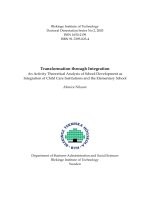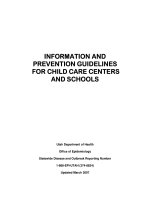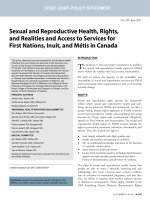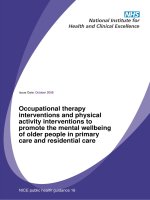Nutrition Education: Action Guide for Child Care Nutrition and Physical Activity Policies doc
Bạn đang xem bản rút gọn của tài liệu. Xem và tải ngay bản đầy đủ của tài liệu tại đây (951.5 KB, 12 trang )
57
6 — NUTRITION EDUCATION
POLICY COMPONENT
NUTRITION EDUCATION
POLICY AREAS
This section addresses best practices for nutrition education in the child care environment including
policy recommendations, rationale, implementation strategies and resources for the following ve
policy areas:
Standards-Based Nutrition Education•
Appropriateness of Nutrition Materials•
Connecting with Planned Learning Experiences•
Nutrition Promotion•
Professional Development•
STANDARDS-BASED NUTRITION EDUCATION
Policy Recommendations
e child care program provides standards-based nutrition f
education that refl ects current science and national guidelines
and is focused on children’s eating behaviors. Nutrition education
aligns with state standards, such as the CSDE’s Connecticut
Preschool Curriculum Framework, A Guide to Early Childhood
Program Development and Healthy and Balanced Living Curriculum
Framework.
Nutrition education is off ered at least once per week as part of f
a planned comprehensive health education program designed
to provide children with the knowledge and skills necessary to
promote and protect their health.
Nutrition education activities are consistent with the Dietary f
Guidelines for Americans and emphasize the appealing aspects
of healthy eating. ey promote nutrient-rich foods, healthy
food preparation methods, good nutrition practices and include
enjoyable, developmentally appropriate and culturally relevant
participatory activities, e.g., cooking, taste-testing and farm
visits.
This section addresses
nutrition education for children.
For information on nutrition
education for families, see
Engaging Families in section
8. For information on nutrition
education for staff members,
see Professional Development
in this section and Food Service
Personnel Quali cations and
Training in section 5.
Nutrition Education
|
6
Action Guide for Child Care Nutrition and Physical Activity Policies
58
Rationale
To develop healthy habits, e Surgeon General’s Vision
for a Healthy and Fit Nation emphasizes that children
need a planned and sequential health education
curriculum for prekindergarten through Grade
12.
33
is curriculum should be based on national
health education standards and address a clear set of
behavioral outcomes that empower children to make
healthy dietary choices and meet physical activity
recommendations.
Educational materials that are consistent with state
or national standards provide relevant science-
based nutrition information that is developmentally
appropriate and focused on developing skills for healthy
eating. By providing positive food experiences, child
care programs help children to develop an awareness
of good nutrition and develop healthy eating habits
for a lifetime. Helping children to make healthy food
choices can promote consumption of a balanced
diet; achievement of optimal growth and intellectual
development; increased physical performance;
maintenance of healthy weight; and decreased risk of
nutrition-related diseases.
Successful nutrition education programs infl uence children’s eating behaviors. e CDC says that nutrition
education strategies are most likely to promote lifelong habits for good health if they help children learn
the skills needed for healthy eating behaviors, provide opportunities to practice these behaviors and
make nutrition education relevant and fun.
65
Activities should be designed to encourage developmentally
appropriate food experiences that help children learn about new and culturally diverse foods and healthy
eating. Nutrition education should:
teach children the relationship between food and health; •
help children understand their growing bodies and how to take care of themselves through positive •
health behaviors;
expose children to a variety of learning experiences about where food comes from and how it can •
be prepared; and
help children develop sound attitudes and knowledge about food, nutrition and health.•
NAEYC standards specify that children are provided varied opportunities and materials to help them learn
about nutrition, including identifying sources of food and recognizing, preparing, eating and valuing healthy
foods.
41
Head Start regulations require that children are provided with opportunities for involvement in
food-related activities, as developmentally appropriate.
39
6
|
Nutrition Education
Action Guide for Child Care Nutrition and Physical Activity Policies
59
Implementation Strategies
Develop a plan for nutrition education that includes opportunities •
for children to develop the knowledge and skills necessary to make
appropriate food choices and is the shared responsibility of all staff
members, including program administrators, teachers and food service
personnel.
38
e plan should devote adequate time and intensity to
focus on behaviors and skill building.
Provide developmentally appropriate nutrition education activities •
based on state health education standards for prekindergarten through
Grade 12, such as the CSDE’s Preschool Curriculum Framework and
the CSDE’s Healthy and Balanced Living Curriculum Framework.
Employ active learning experiences that use developmentally appropriate instructional concepts at each •
age or grade level and introduce children to foods and healthy eating.
Provide concrete experiences that focus on changing specifi c behaviors rather than on learning general •
facts about nutrition, such as increasing exposure to many healthy foods and building skills in choosing
healthy foods, e.g., Captain 5 A Day and MyPyramid for Kids.
Provide culturally relevant nutrition education that addresses the diff erent health concerns, eating •
patterns, food preferences, and food-related habits and attitudes of diff erent cultural groups. For more
information, see Cultural Diversity in section 10.
Integrate nutrition materials and foods into the curriculum that refl ect the diversity of the community, •
e.g., include healthy foods and cooking utensils from a variety of cultures in the dramatic play area,
regularly include foods from various local cultures when cooking, and ensure that literature includes
foods from various cultures.
As age appropriate, include cooking and food-related activities that reinforce and promote health •
messages, e.g., using recipes for healthy foods, taking fi eld trips to farms or orchards and growing
vegetables from seeds.
Follow the CCCNS for foods used in nutrition education activities, e.g., taste tests and cooking. For •
more information, see section 4 and appendix C.
Provide current nutrition resources, games, toys and materials that staff members can use with nutrition •
education activities.
Model healthy behaviors, e.g., staff members eat the same foods with children and talk about nutrition •
and healthy eating habits. For more information, see Modeling Healthy Behaviors in section 5.
Promote healthy eating messages in language families can understand using a variety of methods, •
e.g., posters, parent newsletters, menu backs, program Web site and parent presentations. For more
information, see section 8.
Provide meal programs and food-related policies that reinforce classroom nutrition education. For more •
information, see sections 4 and 7.
Ask families to share healthy recipes that children can prepare as a group cooking activity in child care. •
Encourage children to tell their parents about their food experiences in child care. •
Involve families in nutrition education. For more information, see • Engaging Families in section 8.
SMART STEPS
Provide weekly
nutrition education
activities for children
that focus on
developing healthy
behaviors.
SMART STEPS
Provide weekly
Nutrition Education
|
6
Action Guide for Child Care Nutrition and Physical Activity Policies
60
Resources
A Guide to Early Childhood Program Development, CSDE, 2007:
/>Captain 5 A Day, Connecticut Department of Public Health:
Connecticut Preschool Curriculum Framework, CSDE, 2006:
/>Cultural and Ethnic Food and Nutrition Education Materials: A Resource List for Educators, USDA Food and
Nutrition Information Center, January 2008: />FitSource Physical Activity and Nutrition in Child Care Settings, U.S. Department of Health and Human
Services: tsource/
Food and Nutrition Fun for Preschoolers, USDA Food and Nutrition Information Center, July 2008:
Food and Nutrition Fun for Elementary-Age Children, USDA Food and Nutrition Information Center, July
2008:
Food and Nutrition Information Center, USDA: (click on “Topics A-Z” then
“Nutrition Education” or click on “Resource Lists”)
Healthy and Balanced Living Curriculum Framework, CSDE, 2006:
/>Healthy Meals Resource System for Child Care Providers, USDA:
(click on “Nutrition Education”)
National Food Service Management Institute: (click on “Resource Center”)
MyPyramid for Kids Classroom Materials, USDA:
amidclassroom.html
Team Nutrition, USDA: />For additional resources, see Curriculum Development, Nutrition Education, Nutrition Handouts and
Nutrition Promotions in section 10.
APPROPRIATENESS OF NUTRITION MATERIALS
Policy Recommendations
e child care program reviews all nutrition education lessons and materials for accuracy, completeness, f
balance, cultural relevancy and consistency with the state’s and child care program’s educational goals
and curriculum standards.
e child care program does not use nutrition education materials with corporate logos or advertising.f
6
|
Nutrition Education
Action Guide for Child Care Nutrition and Physical Activity Policies
61
Rationale
To provide consistent and appropriate health messages for children and families, nutrition education
materials must be consistent with established standards and refl ect science-based information. Materials
with corporate logos or advertising contain commercial messages and expose children to product marketing.
ese materials are not appropriate in the child care setting.
Implementation Strategies
Use science-based nutrition education materials from state and national health agencies and •
organizations, such as the USDA, CDC, U.S. Department of Health and Human Services and
Connecticut Department of Public Health.
Determine a schedule for regularly reviewing all curricula and materials to ensure they refl ect current •
health recommendations (e.g., Dietary Guidelines for Americans and MyPyramid) and state standards
(e.g., the CSDE’s Preschool Curriculum Framework, A Guide to Early Childhood Program Development and
Healthy and Balanced Living Curriculum Framework).
Identify appropriate individuals to review nutrition education materials, e.g., curricula, activities, •
handouts and other materials. For licensed child care centers that serve meals, the registered dietitian
consultant can assist with this process. e early childhood education consultant can help to evaluate
the appropriateness of education materials regarding state early childhood education standards. For
more information, see Finding Consultants under Professional Development in section 6.
Resources
A Guide to Early Childhood Program Development, CSDE, 2007:
/>Characteristics of an Eff ective Health Education Curriculum, Centers for Disease Control and Prevention,
2008:
Connecticut Preschool Curriculum Framework, CSDE, 2006:
/>Dietary Guidelines for Americans. USDA and U.S. Department of Health and Human Services, 2005:
/>Healthy and Balanced Living Curriculum Framework, CSDE, 2006:
/>Health Education Curriculum Analys is Tool (HECAT), Centers for Disease Control and Prevention, 2007:
For additional resources, see Evaluating Nutrition Education Materials in section 10.
Nutrition Education
|
6
Action Guide for Child Care Nutrition and Physical Activity Policies
62
CONNECTING WITH PLANNED LEARNING EXPERIENCES
Policy Recommendations
Nutrition education is a part of comprehensive health education f
and is included in other content areas, such as language and literacy
development, mathematics, science and music.
e child care program encourages instructional staff members to
f
incorporate nutrition themes from the CSDE’s Healthy and Balanced
Living Curriculum Framework and A Guide to Early Childhood Program
Development into planned learning experiences, when appropriate, to
reinforce and support health messages.
Nutrition concepts are integrated into daily routines whenever f
possible, such as mealtimes and transitions.
Afterschool programs integrate nutrition activities throughout the learning environment.f
Rationale
An integrated approach to nutrition education is more
eff ective than teaching nutrition only as a discrete
unit, since it is ongoing and continually reinforces
what children are learning. When nutrition education
is linked with other content areas, children have daily
exposure to nutrition concepts and messages. Nutrition
concepts are easily integrated into a variety of content
areas such as language and literacy development,
mathematics, science and music. ey can also be
incorporated into daily routines such as mealtimes
and transitions.
e interdisciplinary approach to nutrition education
should complement and not replace sequential
nutrition education lessons within a comprehensive
health education curriculum.
36
e exclusive use of an
interdisciplinary approach can sacrifi ce key elements
of an eff ective nutrition education program, e.g.,
adequate instructional time, focusing on behaviors
and skill-building, attention to scope and sequence
and adequate teacher preparation.
Implementation Strategies (as developmentally appropriate)
Include appropriate staff members in planning for nutrition activities, e.g., teachers, food service •
personnel, registered dietitian consultant, health consultant, early childhood education consultant and
other program staff members.
6
|
Nutrition Education
Action Guide for Child Care Nutrition and Physical Activity Policies
SMART STEPS
Integrate nutrition
education activities
throughout the
curriculum and into
daily routines.
SMART STEPS
Integrate nutrition
63
Provide training for staff members on strategies for integrating nutrition into diff erent content areas •
and daily routines.
Review current curricula to identify content areas that can incorporate nutrition.•
Identify and use resources that integrate nutrition into other content areas. For more information, see •
Integrating Nutrition in section 10.
Use literature with appropriate health themes, e.g., messages about healthy eating or physical activity. •
For more information, see Michigan State University’s Michigan Team Nutrition Booklist and Michigan
Team Nutrition Preschool Booklist.
Use nutrition to teach math concepts, e.g., charting how many servings of fruits and vegetables children •
eat. Older children can learn to read food labels and compare the nutritional value of foods.
Sing food-themed songs during daily activities such as center learning time, art, cooking, washing hands •
and during transitions between activities.
Demonstrate nutrition-related science concepts, e.g., cooking activities or growing vegetables from seeds. •
Older school-age children can identify foods’ chemical compounds or determine chemical changes in
recipe ingredients, such as the formation of gluten in fl our.
Learn about and research food customs of other countries. Involve children in cooking activities using •
foods from diff erent countries. Older children can create a healthy menu based on the local food
preferences of a specifi c country or ethnic group.
Resources
Michigan Team Nutrition Booklist, Michigan State University, 2006:
/>Michigan Team Nutrition Preschool Booklist, Michigan State University, 2006:
e following resources provide guidance on integrating nutrition and physical activity into afterschool
programs.
Changing Lives, Saving Lives, A Step-by-Step Guide to Developing Exemplary Practices in Healthy Eating,
Physical Activity and Food Security in Afterschool Programs, Center for Collaborative Solutions, 2010:
/>Empowering Youth with Nutrition & Physical Activity, USDA, 2007:
/>Promoting Healthy Eating and Physical Activity in Out-of-School Programs, e Nemours Foundation, 2008:
lebox/nhps/grow-up-healthy/after-school-book.pdf
e Power of Choice: Helping Youth Make Healthy Eating and Fitness Decisions, A Leader’s Guide, USDA, 2003:
/>Resources on connecting nutrition themes to the preschool or school-age curriculum can be found in
Integrating Nutrition in section 10.
Nutrition Education
|
6
Action Guide for Child Care Nutrition and Physical Activity Policies
64
NUTRITION PROMOTION
Policy Recommendations
e child care program conducts nutrition education activities and f
promotions that involve children, families and the community.
e nutrition education program is coordinated with CACFP meals f
and snacks and other foods and beverages available in the child care
environment, such as parties, meetings and other events.
Whenever possible, nutrition education activities involve the entire f
child care program and are linked to health-related community
initiatives, services and programs.
e child care program collaborates with agencies and groups f
conducting nutrition education in the community to send consistent
health messages to children and their families.
Rationale
Promoting nutrition throughout the child care environment provides
consistent health messages for children and families. Linking nutrition
education to CACFP meals and snacks provides children with hands-
on opportunities to practice healthy habits. Participation in community
programs that promote and reinforce health emphasizes the child care
program’s commitment to a healthy child care environment and supports
local nutrition and physical activity eff orts.
Collaborating with community initiatives, services and programs
enhances the child care program’s existing resources. It also increases the
eff ectiveness of local nutrition interventions by providing consistent and
reinforcing health messages to children and families.
Implementation Strategies (as developmentally appropriate)
Promote nutrition in the child care program through a variety of activities, such as cooking, connecting •
with local farmers’ markets and community gardens, sampling popular healthy ethnic foods, and
participating in marketing campaigns promoting nutrition or physical activity messages, e.g., Fruits &
Veggies More Matters.
Collaborate with and participate in community-based programs that promote and reinforce children’s
•
health, such as nutrition initiatives, health fairs, physical activity challenges and food drives. For more
information, see Partnering with Community Organizations in section 8.
Coordinate CACFP meals and snacks with the nutrition curriculum, e.g., fruits and vegetables used for •
a nutrition education activity are featured on the menu and a recipe is sent home for families.
SMART STEPS
Collaborate with
community-based
nutrition programs,
initiatives and services.
SMART STEPS
6
|
Nutrition Education
Action Guide for Child Care Nutrition and Physical Activity Policies
SMART STEPS
Coordinate nutrition
education activities
with CACFP meals
and snacks and other
foods and beverages
available in the child
care environment.
SMART STEPS
Coordinate nutrition
65
Provide healthy choices that refl ect the cultures and customs of families and that meet the CCCNS (see
•
appendix C) whenever foods and beverages are available in the child care environment, including CACFP
meals and snacks, nutrition education and cooking activities, meetings, celebrations and other events.
For school-based centers, link nutrition education with the district’s coordinated school health initiatives.
•
Promote nutrition and physical activity challenges for children, families and staff members, e.g., •
eating the recommended daily servings of fruits and vegetables or meeting daily physical activity
recommendations.
Decorate classroom and dining areas with nutrition and physical activity posters and displays.•
Promote nutrition and physical activity to families and staff members through a variety of methods, e.g., •
bulletin boards, newsletters, fact sheets, program Web site, activities and events.
Plan special events for national health awareness days, such as National Nutrition Month, National •
Diabetes Month, or Fruits & Veggies More Matters Month.
Resources
Coordinated School Health, CSDE:
/>Fruits & Veggies More Matters, Produce for Better Health Foundation:
National Health Observances, U.S. Department of Health and Human Services:
http://healthfi nder.gov/nho/default.aspx.
For additional resources, see Nutrition Promotions and Partnering with Community Organizations in section 10.
PROFESSIONAL DEVELOPMENT
Policy Recommendations
Staff members responsible for nutrition education are adequately f
prepared and regularly participate in professional development
activities to eff ectively deliver the nutrition education program as
planned. e child care program includes relevant nutrition training
at least twice a year for teachers, assistant teachers and other staff
members, as appropriate.
Professional development includes orientation to appropriate f
state standards and curriculum frameworks, such as the CSDE’s
Connecticut Preschool Curriculum Framework, A Guide to Early
Childhood Program Development and Healthy and Balanced Living
Curriculum Framework.
SMART STEPS
Provide training on
nutrition and physical
activity for all staff
members at least
twice a year.
SMART STEPS
Nutrition Education
|
6
Action Guide for Child Care Nutrition and Physical Activity Policies
66
e child care program builds awareness among teachers, food service personnel, consultants and other f
staff members about the importance of nutrition, physical activity, decreased screen time and positive
body image to academic success and lifelong wellness.
Nutrition and physical activity information shared with children, families and staff members is based on f
current science and national health recommendations.
Rationale
It is important for the child care program to
develop and implement a training plan for staff
members. Appropriate training in nutrition
and health education aff ects the quality of
instruction and increases the extent to which
teachers implement the curriculum.
66-67
It
also impacts how staff members behave at
mealtimes, which in turn infl uences children’s
eating behaviors. Staff members’ nutrition
knowledge is correlated with their ability to
positively infl uence children’s eating behaviors
at mealtime, e.g., eating the same foods as the
children, encouraging pleasant conversation,
nutrition education and modeling healthy
eating behaviors.
68
Training should address developmentally and
culturally appropriate content and teaching
strategies while focusing on giving teachers
the skills needed to provide innovative
nutrition education.
65
Staff members also
need to understand basic nutrition concepts
and issues related to children, such as dietary
recommendations and the impact of childhood
obesity. Staff members are better able to
implement and support program policies when
they understand the rationale behind them.
e child care program should include all appropriate staff members in professional development activities
in nutrition, for example, program consultants and food service personnel. (For more information on training
for food service personnel, see Food Service Personnel Qualifi cations and Training in section 5.) All staff
members need to be aware of the importance of nutrition and physical activity to children’s development and
achievement so they can consistently reinforce positive health messages throughout the child care environment.
Appropriate professional development assists staff members with providing accurate nutrition information
that is based on current science and national health recommendations instead of personal beliefs.
6
|
Nutrition Education
Action Guide for Child Care Nutrition and Physical Activity Policies
67
Implementation Strategies
Ensure that staff members responsible for nutrition education are adequately prepared and regularly •
participate in professional development activities to eff ectively deliver the nutrition education program
as planned.
Provide an orientation for all new staff members on basic nutrition and the program’s nutrition and •
physical activity policies.
Encourage staff members to participate in appropriate credentialing programs, such as an associate’s degree •
from a community college, the Child Development Associate (CDA) credential through Connecticut
Charts-A-Course or certifi cation through a bachelor’s degree from a four-year institution.
Off er professional development activities on nutrition at least twice a year, e.g., basic knowledge of •
nutrition, modeling healthy behaviors, and instructional techniques and strategies that are inclusive and
respectful of cultural values and traditions and are designed to promote healthy eating behaviors.
Provide staff members with science-based health information •
regarding benefi ts and risks of dietary habits, health trends,
eff ective strategies for addressing nutrition issues, and food
safety and foodborne illness prevention.
• Off er professional development activities in nutrition to all
appropriate child care personnel, such as program consultants
and food service personnel.
Use appropriate personnel (including registered dietitian •
consultant, health consultant, early childhood education
consultant and food service director) and the community
(including registered dietitians and other health professionals)
to promote awareness and serve as a resource to staff members
for nutrition, nutrition education and the CACFP. For more
information, see Partnering with Community Organizations in
section 8.
Take advantage of Internet-based training, such as online •
courses and seminars. e National Food Service Management Institute provides online training on a
variety of topics related to the USDA Child Nutrition Programs. For more information, see Training for
Teachers and Staff Members in section 10.
Educate staff members regarding the importance of providing nutrition information based on current •
science and national health recommendations, not personal beliefs.
Use only qualifi ed health personnel (e.g., registered dietitian or registered nurse) to provide specifi c •
dietary guidance. Staff members providing nutrition education should not advocate dieting behaviors
or any specifi c eating regimen to children, families or other staff members.
FINDING CONSULTANTS
Education consultants:
Connecticut Early Education
Consultation Network
Health consultants:
Connecticut Nurses Association
/>Registered dietitian consultants:
Connecticut Dietetic Association
/>Nutrition Education
|
6
Action Guide for Child Care Nutrition and Physical Activity Policies
68
Resources
Care Connection, National Food Service Management Institute, 2009:
Child Development Associate (CDA) National Credentialing Program: />Connecticut Charts-A-Course Early Childhood Professional Development System and Registry:
/>Connecticut Community Colleges: />Connecticut’s Approved Education Preparation Programs:
/>Education and Training Materials Database, USDA:
From the Trainer’s Tablet — Lessons for Family/Home Child Care Providers Food Safety in Child Care,
National Food Service Management Institute, 2003:
National Food Service Management Institute:
Online Courses, National Food Service Management Institute:
(click on “Online Courses”)
Team Nutrition, U.S. Department of Agriculture: />For additional resources, see Training for Teachers and Staff Members and Training for Food Service
Personnel in section 10.
6
|
Nutrition Education
Action Guide for Child Care Nutrition and Physical Activity Policies









